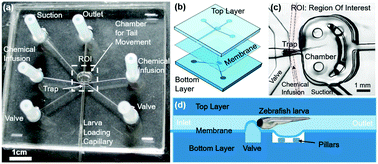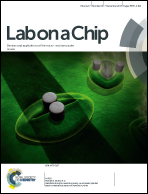A microfluidic device for partial immobilization, chemical exposure and behavioural screening of zebrafish larvae†
Abstract
The zebrafish larva is an important vertebrate model for sensory–motor integration studies, genetic screening, and drug discovery because of its excellent characteristics such as optical transparency, genetic manipulability, and genetic similarity to humans. Operations such as precise manipulation of zebrafish larvae, controlled exposure to chemicals, and behavioural monitoring are of utmost importance to the abovementioned studies. In this work, a novel microfluidic device is presented to easily stabilize an individual larva's head using a microfluidic trap while leaving the majority of the body and the tail unhindered to move freely in a downstream chamber. The device is equipped with a microvalve to prevent the larva's escape from the trap and a microchannel beside the larva's head to expose it to chemicals at desired concentrations and times, while investigating multiple behaviours such as the tail, eye, and mouth movement frequencies. An in situ air bubble removal module was also incorporated to increase the yield of experiments. The functionality of our device in comparison to a conventional droplet-based technique was tested using L-arginine exposure and viability assays. We found that the larvae in the device and the droplet exhibit similar tail and eye response trends to nM–mM concentrations of L-arginine, and that the survival of the larvae is not affected by the device. However, the tail responses in the device were numerically higher than the droplet-tested larvae at nM–mM L-arginine concentrations. In the future, our device has the potential to be used for conducting simultaneous whole-brain functional imaging, upon optimized immobilization of the brain, and behavioural analysis to uncover differences between diseased and healthy states in zebrafish.

- This article is part of the themed collection: Lab on a Chip Emerging Investigators


 Please wait while we load your content...
Please wait while we load your content...